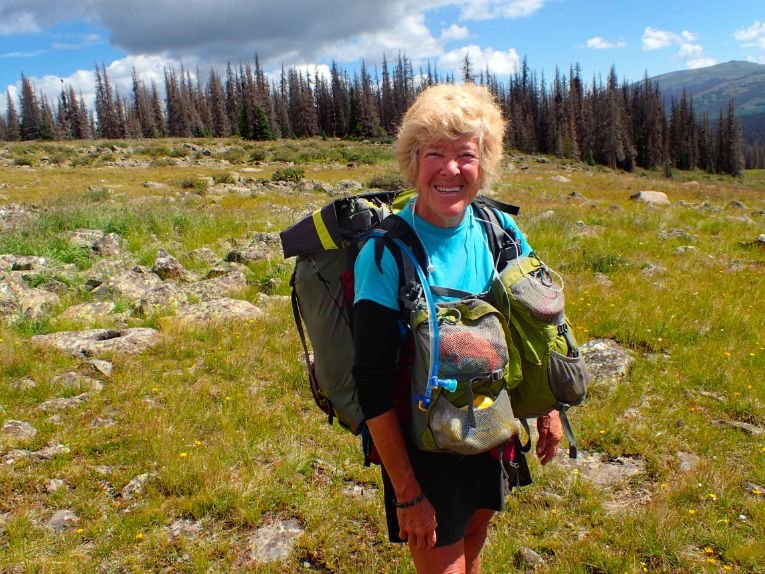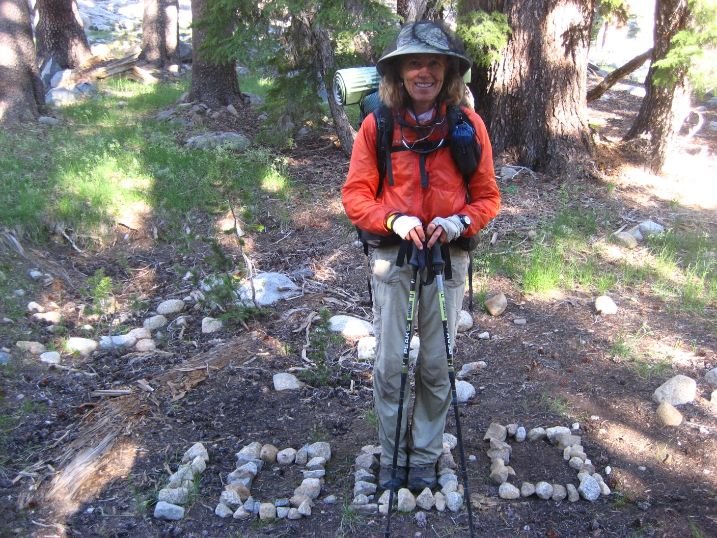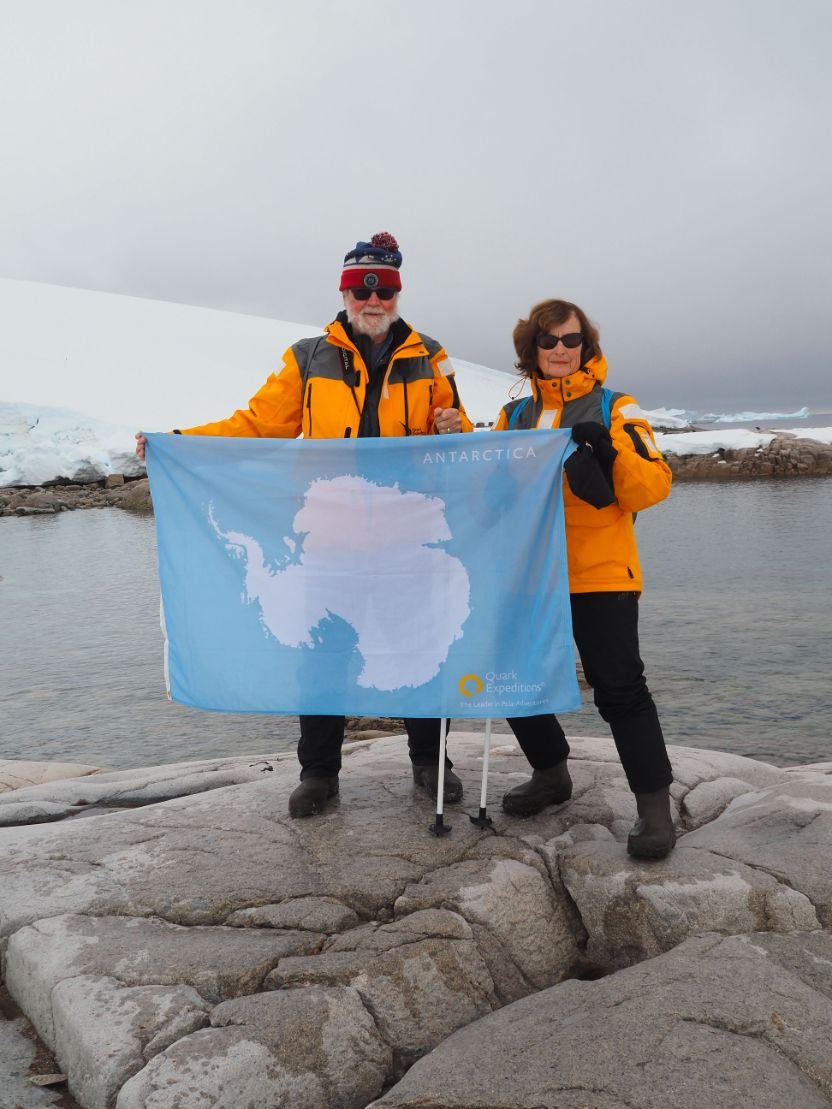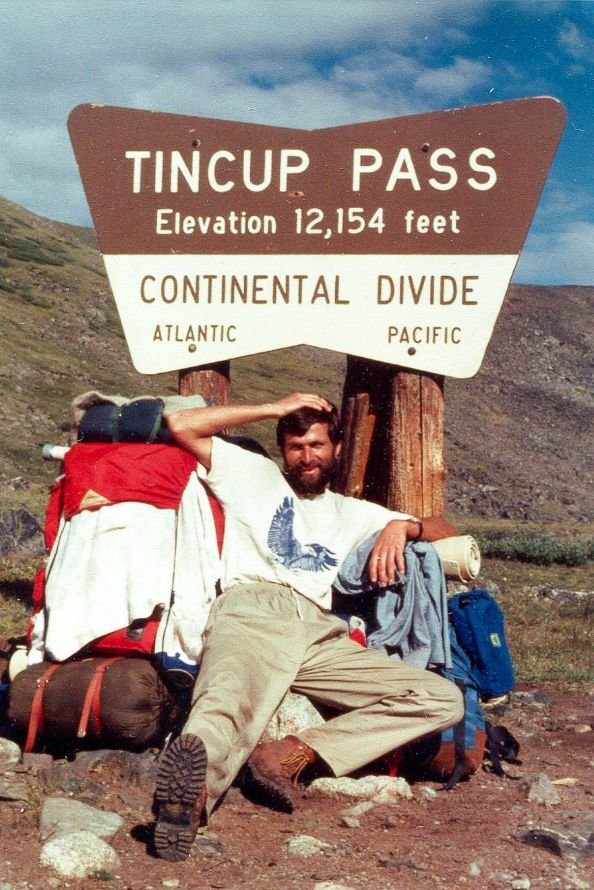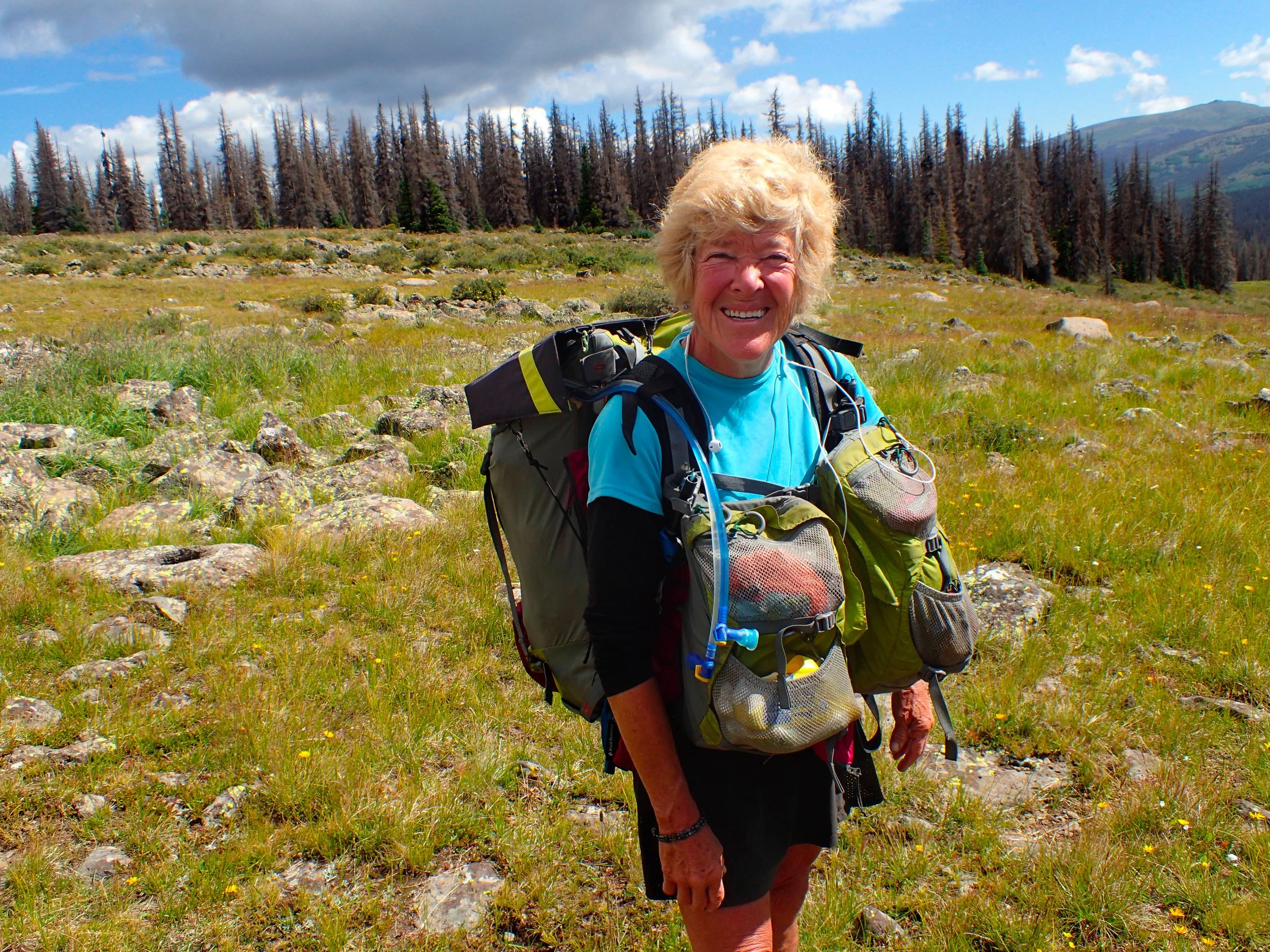How to Thru-hike Over 60 Years Old
5 thru-hikers aged 60+ share advice for staying motivated and in shape
Talie poses for a photograph on The Colorado Trail. Talie had hiked all over the world. The Colorado Trail. Photo by Dean Krakel.
Updated December 17th, 2024
Home > Learn Skills
Is growing older keeping you from fulfilling your thru-hiking dream? Do you feel like you’re too middle-aged to hit the trail?
When I thru-hiked The Colorado Trail in 2015, I really enjoyed meeting people my age (62) and older who were hiking the trail, too—suffering through the same rainy weather and aches and pains. Fellow travelers in the land of old.
There were more hikers over the age of 60 on the trail than I had imagined, and there seemed to be an equal number of men and women, many traveling alone. Being around so many like-minded ancient others inspired me to keep going.
Three years later, while hiking the Continental Divide Trail, I found that while there were many younger people in the woods, there were also lots from the silver-haired over-60 crowd.
What, I wondered, motivated these badass seniors to hike some of the world’s toughest trails? What inspires them? How did they get started? How do they train at their age to continue doing something as hardcore as thru-hiking? What advice on aging and hiking would they give others?
Meet Nancy Huber (70), Susan Alcorn (81), David Fanning (71), Scott Williams (70), and Karl Riters (80), hikers that didn’t start seriously rocking the long trails until middle age and older — and they’re still going strong.
We create reader-supported, objective gear reviews independently selected by our editors. This story may contain affiliate links, which help fund our website. When you click on the links to purchase gear, we may get a commission — without costing you an extra cent. Thank you for supporting our work and mission of outdoor coverage for every body! Learn more.
Nancy "Whynot" Huber (70)
Nancy Huber in 2019 on her thru-hike of the Pacific Northwest Trail. Photo provided by Nancy Huber.
“If you always wanted to hike a long trail, educate yourself about doing it,” Huber, 70, says. “If you have some kind of idea of what you’re getting into and you do it smart and learn as you go, you’ve got a good chance of success,” adding that “for old people, if you don’t have a light pack, you should just stay home. You’re going to get injured.”
Huber was 56 when she quit her dental practice and spent five months hiking the 2,650-mile-long Pacific Crest Trail. Up until then, she hadn’t backpacked for more than 5 consecutive days: “I think I’d read too many adventure books.”
Nancy Huber in 2009 on the PCT - 1000 miles into the best adventure of her life. Photo provided by Nancy Huber.
Huber went on to hike the Appalachian and Continental Divide Trails, making her a Triple Crowner, one of the hiking world’s most prestigious achievements. Since then, Huber has hiked 11 more long trails, including the High Route in the Pyrenees, the Te Araroa in New Zealand, and the Great Divide in Canada. Currently, she is planning to hike from Canada to Mexico on the Desert Trail.
Nancy Huber in 2017 on the Via Alpina 1 in Switzerland. Photo provided by Nancy Huber.
“Novices who want to learn about hiking would benefit by joining hiking and meet up groups,” or going on guided day hikes or even a guided thru-hike, Huber says. “If you’re waiting around to find someone to go hiking with, you might wait long. Your best chance of finding a hiker partner is to find one on the trail, or,” she adds, “just go alone. It’s empowering to go by yourself. You start feeling like a rock star.”
The best way to get in shape for a backpacking trip is to walk while wearing a pack, especially uphill, Huber says.
Related: How to choose a lightweight backpack
Nancy Huber in 2017 on the Pyrenees High Route. Photo provided by Nancy Huber.
“When you’re 60, you can almost pretend you’re not getting old, but in your 70’s, you need to get more real,” says Huber. “You start hiking later in the day and finish hiking earlier. You just slow down.”
Huber shrugs off the risk of being an older person in the backcountry. “Bad things can happen to you just sitting in your house. I haven’t had anything but great things happen to me out there.”
Today, Huber says she is “less and less focused on finishing. I just try to make every day good.”
Nancy’s trail log:
Tahoe Rim Trail
Sierra High Route
Wind River High Route
High Route, Pyrenees
Via Alpina 1, Switzerland
GR 20 - Corsica
Te Araroa - New Zealand
Great Divide Trail - Canada
Teton Crest Trail
Scott Williams on one of his regular training trails, the Dipsea trail on Mt Tamalpais, CA. Photo provided by Scott Williams.
Scott "Shroomer" Williams (70)
“Physically, my key to hiking as an older person is that I hike all the time. I hike every day. If I do that, I can pretty much go out and not get injured,” says Scott Williams, 70.
Williams hiked the Pacific Crest Trail at the age of 57. His prior backpacking experience had never been longer than a couple of weeks. The PCT experience proved “seminal,” he says. “The altruism, the living in beauty, the adventure, the physicality of it. I couldn’t stop.”
After finishing the PCT, Williams went on to hike the Appalachian and Continental Divide trails, becoming a Triple Crowner.
He’s hiked extensively in Europe, done the Frances and Portuguese Coastal routes of the Camino trails with his wife Katie, and recently returned from the Long Crossing of the Lofoten Islands in Norway and the Kungsleden in Sweden. Long Crossing was one of the most challenging trails he’d ever hiked.
See Scott speaking on a panel about Thru-hiker Nutrition: Thru-hiking Food: What I eat on a thru-hike? Distance backpackers share their nutrition tips
Scott Williams says, “Scenes from the Lofoten Islands. That’s my wife Katie and I on a beach there.” Photos provided by Scott Williams.
“The main thing,” he says, “for new people that want to hike long trails is they need to make sure they actually like walking. Focus on hills. The hills are your friends. They are the things that make hiking on a long trail easy. Find any hill you can.”
Scott Williams hiking in the Lofoten Islands. Photo provided by Scott Williams.
Williams says it’s essential to walk on trails. When you hike on concrete, your foot falls in one way. When you hike on trails, your foot falls in many directions.
Williams says that hikers setting off on a long trail should force themselves to slow down—you’ll get strong and make up the miles later on.
Scott Williams says these are “wheel ruts from wagons and chariots on one of the Roman roads we walked on in Portugal.” Photo provided by Scott Williams.
Scott Williams. Scenes from the hiking the Lofoten Islands. Photo provided by Scott Williams.
“Hiking poles are essential,” Williams says. Poles engage the whole body in hiking, aid in forward motion, and take some weight off the knees.
Williams also encourages older hikers to lighten up. “Basically, you can get everything you need at REI except for the big 3.” Seasoned hikers should order shelters, sleeping bags, and backpacks from ultra-light companies.
Scott Williams washing his head on the Camino Portuguese Coastal Route. Photo provided by Scott Williams.
Aging, Williams says, has changed his recovery time. “I didn’t used to need days off. Now I do.” Zero days, taking time off from hiking, are especially important for older hikers. Time to rest, eat, resupply, reenergize and get ready for what’s ahead.
Related: Yoga for Hikers: Poses for Strength and Recovery
An older person should definitely bring a SPOT or InReach or some kind of emergency device, Williams says. Williams met a hiker who post-holed and tore his intestine on an early season SOBO of the CDT in Glacier National Park. The hiker didn’t realize it until he became so weak he collapsed on the trail. He used the emergency button on his SPOT and was rescued within a few hours. In the ER, the doctors found that he had peritonitis and would have died if he had not been rescued. “After I met him and heard his story, I promptly got a SPOT myself. I now have a Garmin inReach.”
Related: The Best Personal Locator Beacons and Sattelite Messengers
“With the right gear and in the right shape, you can do trails well into your 80’s,” Williams says. “For me, the experience of living in beauty every day,” when hiking a long trail, “is one of the most powerful things I’ve done. You live in a way that feels very, very interrelated with your surroundings. It’s a deeply spiritual experience. It renews your faith in humanity.”
Scott Williams shares his view from the top of Skierfe on the Kungsleden in Sweden. Photos provided by Scott Williams.
Scott’s trail log:
INT, Israel’s National Trail
Portuguese Coastal Camino
Long Crossing, Lofoten Islands in Norway
Kungsleden in Sweden
Te Araroa in New Zealand
Susan "backpack45" Alcorn (81)
Susan Alcorn peak bagging on the Nifty Ninety Peak Challenge on the San Francisco Peninsula. Photo provided by Susan Alcorn.
For Susan “Backpack45” Alcorn, variety is key to maintaining hiking interest. Alcorn, 81, and her husband Ralph, 86, just returned from hiking the 112-mile-long Dingle Way in Ireland.
“For me,” Alcorn says, “and I think it’s true of any hiker of any age, you are more apt to stay with it if you’re going to interesting places. I like hiking as a way of exploring, whether it’s new places, new cultures, or the interesting people with you.”
Alcorn is especially attuned to encouraging older people to take up hiking and backpacking. She’s the author of Walk, Hike, Saunter: Seasoned Women Hikers Share Tales of Trails (Amazon | Bookshop.org).
“Age makes a difference,” she says, “but I don’t think it should be the deciding factor. Decide what you want to do and how you can reduce the risk. You can get stronger, but it just takes longer.”
Alcorn didn’t attempt any long-distance backpacking trips until she married her second husband, Ralph.
“Ralph was born in Yellowstone National Park and had lots of experience with backpacking and hiking. So after we got married, I was 56, we did the first part of the John Muir Trail and climbed Mt. Whitney.”
Related: How to Support a Thru-hiker
Susan and Ralph section-hiked the Pacific Crest and John Muir Trails; climbed Kilimanjaro; did the "O" and "W" routes in Chile’s Torres del Paine National Park; and the Frances, Norte, and Primitivo routes of the Camino trails.
Currently, Susan and Ralph are hiking every street in the town of Alameda, California. They live next door in Oakland. Susan estimates it’ll be over 276 miles of streets before they are done. “This is more like strolling than hiking because Alameda is flat!”
Susan Alcorn on a local hike to a peak of the Nifty Ninety Challenge. Photo provided by Susan Alcorn.
Alcorn recommends joining a local hiking club, like the Sierra Club, or going out with a group of experienced hikers to learn more about hiking. “On those hikes, you’re going to meet other people. And that will expand your horizons. Going with a group is a safer way of doing it. It’s also a way of splitting up how much you have to carry.”
Related: A Beginner's Guide to Hiking
Susan Alcorn and Ralph in Antarctica. Photo provided by Susan Alcorn.
She believes when hiking with a group or another person, it’s important to decide “what you want to get out of your hikes and to be sure that the person you’re going with understands that. If you’re going for a multi-day trip, are you an early bird, or do you like to sleep in? You should have conversations about these kinds of things.”
“Being willing to adapt as you need is very important,” Alcorn stressed. “If you need to hike slower or take in less elevation, just go ahead and do it.”
Related: How to Take Care of Your Feet while Hiking and Backpacking
Alcorn also believes that lightening up the pack you’re carrying is key to staying on the trail by avoiding injuries and being less physically taxed.
And there are ways to lighten the load that don’t involve investing in ultralight gear. “Many people do hikes in Europe and use different services to carry their equipment or food. In the Sierras, people will have a mule team deliver their food to prearranged locations. There are many ways to reduce the weight of what you’re carrying.”
Susan Alcorn on the beach along the Dingle Way, Ireland in 2022. Photo provided by Susan Alcorn.
Using hiking poles is very important, says Alcorn. “I notice that many younger hikers don’t use them, but I generally find them essential… my balance is poor, so they keep me more stable— especially important on narrow mountain trails, muddy paths, and stream crossings. They take some stress off the lower body, saving some wear and tear on the knees, hips, and feet while strengthening the upper body. They make ascending hills and mountains easier and descending safer. And on level ground, you can use them to increase speed. They have other uses, such as pitching certain tents, encouraging rattlesnakes to move, warding off a dog attack, and also for entertainment! When I’m bored, I like to twirl my batons like a cheerleader!”
Related: The Top 13 Reasons to Use Trekking Poles
The most important thing for older hikers, says Alcorn, is “to keep moving. It’s much harder not to hike much and then take it up.” More importantly, “Don’t compare yourself with younger people.”
Susan’s trail log:
50% of the 550-mile Bay Area Ridge Trail
Sierra Club, Bay Chapter Challenge. (Nifty Ninety Peaks Challenge)
"O" (Circuit" route) and ."W" route in Torres del Paine National Park, Chile
Kilimanjaro
70 miles of the Dingle Way
Routes of the Camino de Santiago:
Frances (the best known)
Norte
Primitivo
and a bit of the Mozarabe France:
the LePuy route
Arles
Vezelay
Porto
Related: read more awesome pro tips and inspiring stories in our story on “Skiing Beyond Age 60”.
Karl "Pringles" Riters (80)
Karl Riters poses at a high point of The Colorado Trail during his 2nd thru hike. (photo provided by Karl Riters)
Karl “Pringles” Riters thru-hiked the 486-mile long Colorado Trail twice, the first time at age 73 in 2014 and the 2nd time, in 2021, at age 80.
Although Riters was drawn to The Colorado Trail by its beauty, the physical challenge also inspired him. He sees doing the trail as a way of maintaining his fitness.
“I don’t consider myself strong,” Riters says. “My goal is to be fit. Doing a hike like that gives me the incentive to get in shape.”
Related: Backpacking the Collegiate Loop, Colorado
Riters created a rigorous training regime of lifting weights, bicycling, and stretches for himself but doesn’t think such a training routine is necessary. Other older hikers like Williams may disagree, but just walking the trails got Riters in shape. “I always tell people, within 2 weeks, you’ll be in shape, but those first couple of weeks will be tough.”
For his first Colorado Trail trip, Riters spent a lot of time studying nutrition and putting together menus that would sustain the 3-4 thousand daily calories he estimated he’d need. “My food targets were 50% carbs, 25% fat, and 25% protein for a total of 3,400 calories. But what I learned was that at my slower than typical hiking pace, 3,400 daily calories was way too much, and I ended up not eating a lot of the food I packed.”
On Riter’s second CT hike, “I planned food for 2,000 calories a day, and that worked out well.” Other than using protein bars and a protein drink mix, he didn’t consciously up his protein take and had no problems nutritionally.
Related: Thru-hiking Food: What I eat on a thru-hike? Distance backpackers share their nutrition tips
Karl Riters poses with some hiking companions during his 2nd Colorado Trail hike. On the left is “Chairman” - he carried a chair in his backpack. Middle guy is named “Pipes” - he carried a bagpipe and played a tune for me. My trail name is “Pringles” - on first CT hike I carried many tubes of Pringles because they provided lots of calories/ounce. (photo provided by Karl Riters)
“It’s a little frustrating to see the youngsters shoot by me,” Riters says. “But at my age, you have to accept that.”
Riters says it's crucial for older hikers to lighten up their gear. On his first Colorado Trail trip, his pack had a base weight—the weight of everything he’d be carrying except food, water, and fuel—of 11.0 lbs. In 2021, his pack base weight was 13.2 pounds. The weight increase between the 1st and 2nd trips was due to adding a full-length sleeping pad (versus the ¾ length he carried before) and some warmer, long underwear. Older hikers with slower metabolisms, thinner skin, and poorer circulation that comes with aging may feel chillier than their younger counterparts and need to beef up their layering and sleeping systems.
Every 4 or 5 days, Riters took a day or two off the trail to relax and enjoy the trail towns, one of the highlights of hiking a long trail.
Riters noticed a decline in his physical endurance in the 7 years between his first and second Colorado Trail hikes. At 80, he found the 2nd trip much more difficult. “It was frustrating to stop so often and catch my breath. Some of the climbs were rough, and some of the weather I ran into was rough, up on a ridge, below freezing, the wind blowing 40mph, and my hands were numb. That sort of stuff is tough, but you just sort of push through it. I consider myself mentally strong.”
Riters strongly advises older hikers to use poles. “For me, hiking poles are essential for safety. They have saved me many times from falls. They are especially important for older hikers as balance and agility continue to decline.”
Related: How to Choose Trekking Poles
Karl Riters tent, one of his favorite photographs from his 2nd Colorado Trail thru hike. (photo provided by Karl Riters)
Was his family concerned about an 80-year-old man hiking solo on a remote mountain trail?
“They were concerned about me going out,” Riters says. “But once I decided that I was going to do it, they were very supportive.” Riters carries a Garmin inReach, satellite communicator. The Garmin inReach, like SPOT devices, communicates by using satellite networks instead of the cell towers used by cell phones. Since there isn’t always cell service on trails a cell phone can’t really be relied upon in an emergency.
By using a Garmin or SPOT a hiker has the 24/7 ability to press an S.O.S. button on the device and summon help or even communicate with family members or hiking partners. Most emergency satellite communicators require a modest subscription. Riters used his Garmin to send messages to his family in the evening when he stopped hiking and again in the morning when he starts.
Related: The Best Satelite Messenger and Personal Locator Beacons
“I feel very comfortable out there. I don’t feel nervous,” Riters says. “I don’t consider mountain lions and bears a big concern. One night a mountain lion started screaming about 50 yards from my tent. I just thought, ‘whatever,’ and went back to sleep.”
Before taking up backpacking, Riters was a passionate golfer. His wife asked him when he was going to start golfing again. “I told her I’d take it back up when I got old."
David Fanning on the summit of Hope Pass during a backpacking trip on The Colorado Trail. Photo provided by David Fanning.
David “Rawah Ranger” Fanning (71)
Dave “Rawah Ranger” Fanning thru-hiked the 486-mile-long Colorado Trail for the first time in 2014 at age 63. In 2021 Fanning, now 71, completed the trail for the 6th time.
“I can’t keep up with the young people anymore,” Fanning says. “I’m very content to hike at my own pace. I camp where I end up. If I get to a nice camp at two in the afternoon, I camp and don’t worry about it. That’s one of the nice things about being retired. You don’t have to be someplace at some particular time.”
When he was 20, Fanning bought some backpacking gear at JCPenney and set off to hike the Pacific Crest Trail. “I didn’t know anything about backpacking. I’d never gone backpacking. I took off with ten days worth of food and had no idea how to get more food. It was the disaster you would think it would be.”
Related: Backpacking for Beginners: Tips to Get Started on Your First Backpacking Trip
During an early backpacking trip on the Continental Divide trail David Fanning takes a break after carrying his oversized pack up Tincup Pass. Photo provided by David Fanning.
Despite the hardship, Fanning stayed on the PCT for 40 days before quitting. “I was wet and cold, and it snowed on me. The last night on the trail, it was raining and really cold. I spent the night in an outhouse. It was just the best trip ever!”
Related: Our Favorite PCT Gear
David Fanning pauses for a break on Kokomo Pass during a backpacking trip on the Continental Divide trail. Photo by Dean Krakel.
Fanning trains for The Colorado Trail by playing tennis and pickleball and taking daily walks around his neighborhood or in nearby mountain parks. A long trail, Fanning says, “it’s really just a walk. If your pack is light enough, you can sort of walk yourself into shape.”
“A hike of any length is more about mental preparation than physical preparation,” Fanning says. “What gets people off the trail is they aren’t mentally prepared for what they’re going to experience. People look too far down the road. My trail is the next 5 or 10 miles.”
“It’s important,” Fanning says, “to live in the moment, taking whatever comes. Thru-hiking should be an adventure. And a sense of humor helps.”
David Fanning in the Maroon Bells Wilderness during a trip on the Four Pass Loop in early October. Photo by Dean Krakel.
Although he sees many people on the trail carrying enormous backpacks, “all with smiles on their faces,” Fanning says it is important for older hikers to lighten their loads. “I don’t like it when my backpack goes over 25 pounds.”
Fanning treats long-distance hiking as a meditation. “It’s a way of just being totally present day after day after day. It’s like a spiritual retreat. Sometimes, I’ve gotten up to San Luis Pass, and just burst into tears. Just seeing that again. You don’t know how many times are left in your life to do that.”
Related: Getting Started with Forest Bathing
Reflections from the Author, Dean Krakel (70)
Author Dean Krakel in evening light on the White Rim Trail, Island in the Sky District, Canyonlands National park in 2021. Age 69. Photo by Dean Krakel.
Hiking The Colorado Trail at age 62 was a life-changing experience for me. The trail made me become more of a minimalist, living without a lot of the material things I thought were necessary for comfort and happiness in hiking and life.
Walking the trail made me more self-reliant and confident. Especially after meeting so many others my age and older. If they can do this, I can do it.
Before hiking the Colorado Trail I didn’t know what thru-hiking, thru-hikers, or long trails were. My hiking horizons were expanded, and along with that knowledge came many new friends.
My faith in humanity was renewed by the kindness of so many trail angels, townspeople, and fellow travelers.
Most of all, I found the trail to be a place of healing, peace, simplicity, and beauty.
Author Dean Krakel hiking on the Peekaboo Springs trail in the Needles District of Canyonlands National Park, Utah. Age 67. Photo by Dean W. Krakel.
And now, at age 70 I’m going to walk The Colorado Trail again. I’m curious to see what differences 8 years have wrought within me and to the trail.
Being older and thinking about another thru hike made the words of Nancy, Scott, Susan, Karl and David resonate with me. Like them, I have lightened my pack load, slowed my pace (really not much choice about that as we age), increased my daily walking, incorporated more hills into it and bought and use a Garmin inReach.
My training approach differs in that I don’t believe just walking the trail will put me in shape. Like Karl Ritter, I like to train, and training for a long hike is highly motivational. I incorporate cycling, both gravel and mountain biking, into my training. I use a rowing machine. I try to walk at least 3-5 miles a day. I do kettlebells 2-3 times a week, use bands, especially for strengthening my ankles and knees, and stretch for at least 10 minutes every morning and evening. Necessary? Probably not for everyone, but it works for me.
Related: How to Get into Mountain Biking
Read More: How to get Started Bikepacking
The author, Dean Krakel, hiking in Wyoming's Wind River Range on the Continental Divide Trail in 2018. Age 66. Dean Krakel hiking in various situations. Photo by Dean Krakel,
In the past I never went on any trail without hiking poles. They’re certainly handy for pitching ultralight shelters, fording streams and helping take pressure off the knees during downhills, as well as using them to make noise in dense brush in bear country but lately I’ve enjoyed hiking without poles. Hands free walking! Without poles I find myself more mindful of where I’m placing my feet. We’ll see how that works out.
While I don’t compare myself to others I do compete with my past self. I’m working on stopping this whenever it occurs. Just as we can’t compete with younger hikers we can’t compete with the things our younger selves were capable of.
Author Dean Krakel hiking on the Continental Divide Trail in Colorado near Cottonwood Pass. Age 67. Photo by Morgan Dzak.
My ambitions are often larger than my abilities. I may plan on hiking up and over the mountain and around the ridge, but the reality may be that getting up the mountain may be enough. And on some days, just getting halfway up the mountain. There’s nothing wrong with having a wider, more ambitious perspective, and there’s also nothing wrong with falling short or changing it up — even mid-hike or maybe even especially mid-hike.
Author Dean Krakel gets a hug from his 7 month old puppy, Pelli, (short for Kokopelli) while hiking the Continental Divide Trail on Snow Mesa in Colorado in 2022. Age 69. Photo by Laine Walter.
I’m not afraid to end a hike short of the goal, and I’m happy to rein in my daily ambitions. It’s never too late to turn back from a bad decision, no matter how much time, money, preparation or emotional investment is involved.
I rest more. I take naps along the trail. I’ll take time off from the trail whenever I feel the need. I sleep in and go to bed early. Maybe one zero day isn’t enough. Maybe 2 are needed to recover from a particularly challenging section or to get over some soreness.
Mainly though, I am learning to be at peace with my older self, to be more forgiving, to stress less over where I think I should be, and to enjoy being where I am.
About the Author / Why You Should Trust Us
Dean Krakel is a three-time Pulitzer-prize-winning photojournalist, photographer, and photo editor whose work appears in National Geographic, Rolling Stone, Cowboys & Indians, High Country News, National Wildlife, Outside, Time, Yoga Journal, Newsweek, and Life magazines.
With over four decades of experience, his early dramatic documentary-style photographs of the Marlboro Man shot for the Leo Burnett Agency were seen worldwide.
In 2015 he left his newspaper career to hike the 500-mile-long Colorado Trail; a film about that hike—The Long Haul—won a Heartland Emmy Award. His latest project is hiking and photographing the 3,100-mile-long Continental Divide Trail. In 2023, he hopes to thru-hike the Colorado Trail again.
Dean is the author of three books: Season of the Elk, Downriver, and Krakel’s West. He is based in Crested Butte, Colorado.
Video Interview with Panelists
This live-event is a follow-up to the written portion of the popular How to Thru-hike Over 60 article by Dean Krakel. It was recorded live with an Zoom audience on Wednesday, February 15th, 2023.
The thru-hikers over 60 who were interviewed for this story share about their tips, gear, training, and recovery.
Panel moderated by Dean Krakel. Followed by Q&A from the audience.

